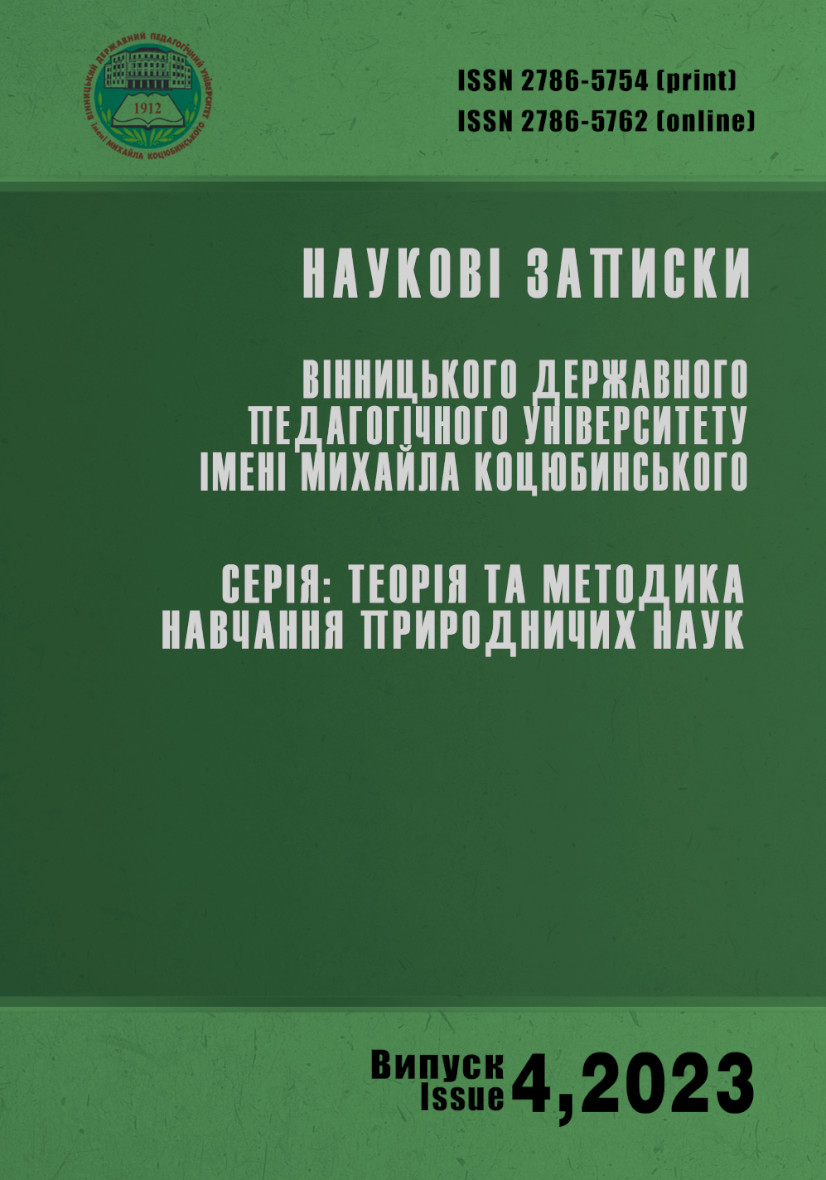Анотація
У статті проведений аналіз наукових джерел щодо ключових напрямків змін у хімічній освіті, і визначено можливості застосування європейського та світового досвіду під час викладання та навчання хімії. У якості освітніх перспектив запропоновані наступні: змінити цілі викладання та навчання хімії таким чином, щоб сприяти їх доречності у повсякденному житті та в професійній діяльності; зв‟язати знання, які були отримані в ході вивчення природничих наук на більш ранніх етапах, та модифікувати їх під задачі, що розглядаються вищою хімічною освітою; визнати, що викладання хімії є науково- обґрунтованою професією, що постійно розвивається та осучаснюється.
У роботі розглянута доцільність застосування інноваційних засобів навчання таких, як онлайн-платформа BACON, додаток для смартфонів Backside Attack, програми QR Chem, технології віртуальної реальності (VR) і доповненої реальності (AR), технологій адитивного виробництва, відомих як 2D- і 3D-друк для викладання хімічних дисциплін. Продемонстровано можливість адаптації YouTube-каналу під навчальні цілі та підкреслено необхідність створення хімічного YouTube-каналу.
Проведений аналіз наукових джерел свідчить про те, що використання сучасних підходів, способів та засобів викладання і навчання хімії спрямовує студентів на формування особистих навичок. Отриманий досвід студенти зможуть реалізовувати у професійній діяльності та використовувати у побуті, а також покращувати протягом усього життя. Очікуваним результатом таких освітніх інновацій є виховання міждисциплінарних, кваліфікованих, креативних спеціалістів, які володіють системним та критичним мисленням, та сучасних викладачів, які максимально орієнтовані на студентів.
Планується впровадження означених інноваційних підходів для викладання університетських курсів загальної та неорганічної хімії, колоїдної хімії, медичної хімії, фізичної хімії, органічної хімії, хімічного матеріалознавства, сучасного хімічного перфомансу та інших
Посилання
Eilksa I., Byersb B. The need for innovative methods of teaching and learning chemistry in higher education – reflections from a project of the European Chemistry Thematic Network. Chem. Educ. Res. Pract. 2010. Vol. 11. P. 233–240.
Pazicni S., Flynn A. B. Systems thinking in chemistry education: theoretical challenges and opportunities. J. Chem. Educ. 2019. Vol. 96, No 12. P. 2752–2763.
Hofstein A. The laboratory in chemistry education: thirty years of experience with developments, implementations and research. Chem. Educ. Res. Pract. 2004. Vol. 5, No. 3. P. 247–264.
George-Williams S. R., Ziebell A. L., Thompson C. D., Overton T. L. What do you think the aims of doing a practical chemistry course are?‘ A comparison of the views of students and teaching staff across three universities. Chem. Educ. Res. Pract. 2018. Vol. 19. P463–473.
Taber K. S. Building the structural concepts of chemistry: some considerations from educational research chemistry educations. Research and Practice in Europe. 2001. Vol. 2, No 2. P. 123–158.
Semmlera L., Pietzne V. Creativity in chemistry class and in general – German student teachers‘ views Chem. Educ. Res. Pract. 2017. Vol. 18. P. 310–328.
Taber K. S. Learning generic skills through chemistry education (Editorial). Chem. Educ. Res. Pract. 2016. Vol. 17. P. 225–228.
Seery M.K. Flipped learning in higher education chemistry: emerging trends and potential directions. Chem. Educ. Res. Pract. 2015. Vol. 16. P. 758–768.
York S., Lavi R., Dori Y. J., Orgill M. K. Applications of Systems Thinking in STEM Education. J. Chem. Educ. 2019. Vol. 96, No 12. P. 2742–2751.
Ippoliti F. M., Charia J. V., Garg N. K. Advancing global chemical education through interactive teaching tools. Chem. Sci. 2022. Vol. 13. P. 5790–5796.
Ambrosi A., Rong R., Shia S., Webster R. D.3D-printing for electrolytic processes and electrochemical flow systems. J. Mater. Chem. 2020. Vol. 8. P. 21902–21929.
Ali N., Ullah S.Review to analyze and compare virtual chemistry laboratories for their use in education. J. Chem. Educ. 2020. Vol. 97, No 10. P. 3563–3574.
Blonder R., Jonatan M., Bar-Dov Z., Benny N., Rap S., Sakhnini S. Can You Tube it? Providing chemistry teachers with technological tools and enhancing their self-efficacy beliefs. Chem. Educ. Res. Pract. 2013. Vol. 14, P. 269–285.
García-Ortega A. R. H., Hernández-Ayala L. F., Guerrero-Ríos I., Gracia-Mora J., Reina M. CADMIO: creating and curating an educational YouTube Channel with chemistry videos J. Chem. Educ. 2021. Vol. 98, No 11. P. 3593–3599.
Bussey Th. J., Orgill M. K., Crippenb K. J. Variation theory: a theory of learning and a useful theoretical framework for chemical education research. Chem. Educ. Res. Pract. 2013. Vol. 14. P. 9–22.
Ghani B. A., Ibrahim N. H., Yahaya N. A., Surif J. Enhancing students‘ HOTS in laboratory educational activity by using concept map as an alternative assessment tool. Chem. Educ. Res. Pract. 2017. Vol. 18. P. 849–874.
Zoller U. Alternative assessment as (critical) means of facilitating HOCS-promoting teaching and learning in chemistry education. Research and Practice in Europe. 2001. Vol. 2, No 1. P. 9–17.
Tolppanen A. S., Akselab M., Eilks I. The potential of the non-formal educational sector for supporting chemistry learning and sustainability education for all students – a joint perspective from two cases in Finland and Germany. Chem. Educ. Res. Pract. 2017. Vol. 18. P. 13–25.
Popova M., Kraft A., Harshman J., Stains M. Changes in teaching beliefs of early-career chemistry faculty: a longitudinal investigation. Chem. Educ. Res. Pract. 2021. Vol. 22. P. 431–442.
Zimmermann F., Melle I., Huwer J. Developing prospective chemistry teachers‘ TPACK−A comparison between students of two different universities and expertise levels regarding their TPACK self-efficacy, attitude, and lesson planning competence. J. Chem. Educ. 2021. Vol. 98, No 6. P. 1863–1874.
Burmeister M., Schmidt-Jacob S., Eilks I. German chemistry teachers‘ understanding of sustainability and education for sustainable development – an interview case study. Chem. Educ. Res. Pract. 2013. Vol. 14. P. 169–176.
Talanquer V., Bucat R., Tasker R., Mahaffy P. G. Lessons from a pandemic: educating for complexity, change, uncertainty, vulnerability, and resilience. J. Chem. Educ. 2020. Vol. 97, No 9. P. 2696–2700.

Ця робота ліцензується відповідно до ліцензії Creative Commons Attribution 4.0 International License.
Авторське право (c) 2023 Тетяна Денисенко, Надія Стець

